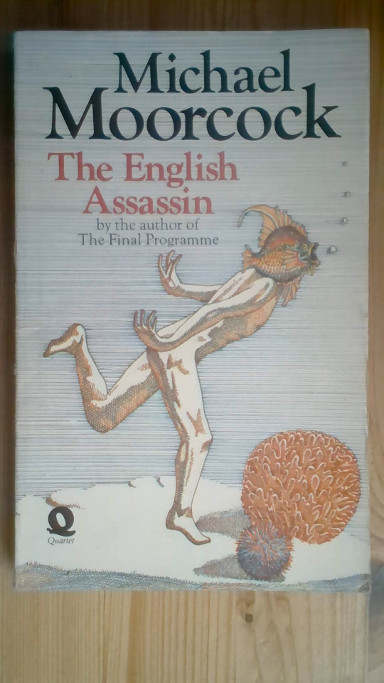
The novel “The English Assassin” by Michael Moorcock was published for the first time in 1972. It’s the third novel in the Jerry Cornelius series and follows “A Cure for Cancer“.
Jerry Cornelius looks more dead than alive when he is recovered from the sea. Helpless, he becomes a trading pawn in a geopolitical game involving various factions, including the Cornelius family. Various possible apocalypses might be near.
The stories of Jerry Cornelius are set in different universes with different versions of this character. For this reason, they can be read independently and out of their publication order. This offers a kaleidoscopic impression that fits very well not only with the series centered around this character but in general with the whole multiverse created by Michael Moorcock. In particular, from a stylistic point of view, it reflects very well the period in which the author wrote the so-called quartet consisting of four novels with Jerry Cornelius.
The novels of this quartet are linked to the new wave, a literary current that Michael Moorcock began to actively promote both as editor of the magazine “New Worlds” and as a writer. They combine the new wave with the concept of Eternal Champion present in much of the author’s production. Jerry Cornelius is an ambiguous version of the Eternal Champion, to say the least.
Also as regards the plot, “The English Assassin” offers a development linked to the new wave with a division into various parts that show a fragmentation of the plot. In the Jerry Cornelius quartet novels, Michael Moorcock experimented with various ways of handling the plot. However, you can’t say that it’s a choice in which style comes before substance because in that type of experimentalism style is a part of the substance.
In “The English Assassin” the tones tend to be very dark, even compared to the previous novels in the series, with the prospect of various possible apocalypses. The various parts are preceded by news headlines of the time, typically linked to the killing of young people and even children. It’s a chaotic world, and it’s no coincidence that the novel’s subtitle is “A Romance of Entropy”.
Jerry Cornelius himself is close to death, and in this novel other characters are more present, starting with his family and in particular his mother. There are also other recurring characters of the quartet such as Una Persson and Miss Brunner.
The stylistic choices accompany profound themes often linked to the legacy of the former British Empire. Colonialism, with the elements of racism, and its consequences, is one of the themes linked to the ethical and moral elements of “The English Assassin”. The association of such themes with the stylistic weirdness of a new wave work is curious. However, they’re strong themes, with important developments even decades after this novel’s publication.
The theme of sexuality remains present but seems to have a lesser importance than in previous novels. In the 1960s, it was also a theme of breaking with the classic conventions of a science fiction world that was asexual, but in many works, it’s addressed in a way that today is dated because it’s a theme that is now a part of the world of science fiction. The minor presence in this novel is therefore good because it makes it less dated.
“The English Assassin” is part of the more mature production linked to the new wave current. It has an unconventional structure and is once again fragmented in its plot, but it seems almost linear compared to “A Cure for Cancer”. It’s a must-read for the people who appreciate this literary current.

